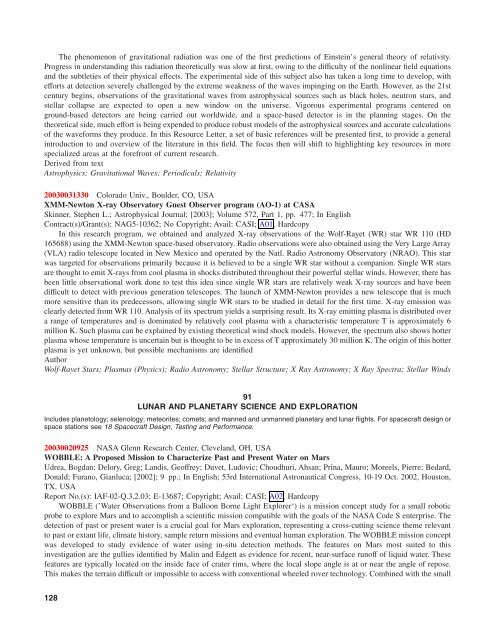You also want an ePaper? Increase the reach of your titles
YUMPU automatically turns print PDFs into web optimized ePapers that Google loves.
The phenomenon of gravitational radiation was one of the first predictions of Einstein’s general theory of relativity.<br />
Progress in understanding this radiation theoretically was slow at first, owing to the difficulty of the nonlinear field equations<br />
and the subtleties of their physical effects. The experimental side of this subject also has taken a long time to develop, with<br />
efforts at detection severely challenged by the extreme weakness of the waves impinging on the Earth. However, as the 21st<br />
century begins, observations of the gravitational waves from astrophysical sources such as black holes, neutron <strong>star</strong>s, and<br />
stellar collapse are expected to open a new window on the universe. Vigorous experimental programs centered on<br />
ground-based detectors are being carried out worldwide, and a space-based detector is in the planning stages. On the<br />
theoretical side, much effort is being expended to produce robust models of the astrophysical sources and accurate calculations<br />
of the waveforms they produce. In this Resource Letter, a set of basic references will be presented first, to provide a general<br />
introduction to and overview of the literature in this field. The focus then will shift to highlighting key resources in more<br />
specialized areas at the forefront of current research.<br />
Derived from text<br />
Astrophysics; Gravitational Waves; Periodicals; Relativity<br />
20030031330 Colorado Univ., Boulder, CO, USA<br />
XMM-Newton X-ray Observatory Guest Observer program (AO-1) at CASA<br />
Skinner, Stephen L.; Astrophysical Journal; [2003]; Volume 572, Part 1, pp. 477; In English<br />
Contract(s)/Grant(s): NAG5-10362; No Copyright; Avail: CASI; A01, Hardcopy<br />
In this research program, we obtained and analyzed X-ray observations of the Wolf-Rayet (WR) <strong>star</strong> WR 110 (HD<br />
165688) using the XMM-Newton space-based observatory. Radio observations were also obtained using the Very Large Array<br />
(VLA) radio telescope located in New Mexico and operated by the Natl. Radio Astronomy Observatory (NRAO). This <strong>star</strong><br />
was targeted for observations primarily because it is believed to be a single WR <strong>star</strong> without a companion. Single WR <strong>star</strong>s<br />
are thought to emit X-rays from cool plasma in shocks distributed throughout their powerful stellar winds. However, there has<br />
been little observational work done to test this idea since single WR <strong>star</strong>s are relatively weak X-ray sources and have been<br />
difficult to detect with previous generation telescopes. The launch of XMM-Newton provides a new telescope that is much<br />
more sensitive than its predecessors, allowing single WR <strong>star</strong>s to be studied in detail for the first time. X-ray emission was<br />
clearly detected from WR 110. Analysis of its spectrum yields a surprising result. Its X-ray emitting plasma is distributed over<br />
a range of temperatures and is dominated by relatively cool plasma with a characteristic temperature T is approximately 6<br />
million K. Such plasma can be explained by existing theoretical wind shock models. However, the spectrum also shows hotter<br />
plasma whose temperature is uncertain but is thought to be in excess of T approximately 30 million K. The origin of this hotter<br />
plasma is yet unknown, but possible mechanisms are identified<br />
Author<br />
Wolf-Rayet Stars; Plasmas (Physics); Radio Astronomy; Stellar Structure; X Ray Astronomy; X Ray Spectra; Stellar Winds<br />
91<br />
LUNAR AND PLANETARY SCIENCE AND EXPLORATION<br />
Includes planetology; selenology; meteorites; comets; and manned and unmanned planetary and lunar flights. For spacecraft design or<br />
space stations see 18 Spacecraft Design, Testing and Performance.<br />
20030020925 NASA Glenn Research Center, Cleveland, OH, USA<br />
WOBBLE: A Proposed Mission to Characterize Past and Present Water on Mars<br />
Udrea, Bogdan; Delory, Greg; Landis, Geoffrey; Duvet, Ludovic; Choudhuri, Ahsan; Prina, Mauro; Moreels, Pierre; Bedard,<br />
Donald; Furano, Gianluca; [2002]; 9 pp.; In English; 53rd International Astronautical Congress, 10-19 Oct. 2002, Houston,<br />
TX, USA<br />
Report No.(s): IAF-02-Q.3.2.03; E-13687; Copyright; Avail: CASI; A02, Hardcopy<br />
WOBBLE (’Water Observations from a Balloon Borne Light Explorer‘) is a mission concept study for a small robotic<br />
probe to explore Mars and to accomplish a scientific mission compatible with the goals of the NASA Code S enterprise. The<br />
detection of past or present water is a crucial goal for Mars exploration, representing a cross-cutting science theme relevant<br />
to past or extant life, climate history, sample return missions and eventual human exploration. The WOBBLE mission concept<br />
was developed to study evidence of water using in-situ detection methods. The features on Mars most suited to this<br />
investigation are the gullies identified by Malin and Edgett as evidence for recent, near-surface runoff of liquid water. These<br />
features are typically located on the inside face of crater rims, where the local slope angle is at or near the angle of repose.<br />
This makes the terrain difficult or impossible to access with conventional wheeled rover technology. Combined with the small<br />
128
















